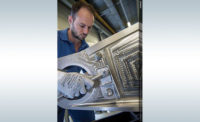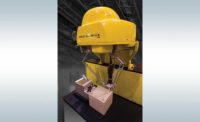Investing in automation requires a major commitment of time, money and other valuable resources. Unfortunately, end users often repeat the same mistakes with automation, because of time constraints and budget concerns.
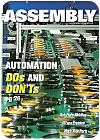
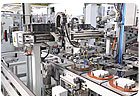
Investing in automation requires a major commitment of time, money and other resources. While there’s a right way and a wrong way for every application, headaches inevitably occur along the way.
Manufacturers typically turn to automation to lower costs, increase yields, decrease cycle times, improve product quality and gain a competitive edge. Most companies want high-speed assembly machines, conveyors, feeders, fixtures, robots, vision systems and other equipment capable of repeatable, high-volume production.
Any type of automation project must be competitive in price, provide a positive return on investment and be delivered on time. However, manufacturers are demanding more value from automation equipment today, because they are under intense pressure to compete and control production costs. As automotive parts, consumer goods, electronics, medical devices and other products get smaller and more complex, demand for automation continues to increase.
Unfortunately, end users often repeat the same mistakes with automation, because of time constraints and budget concerns. But, many of those problems can be avoided if engineers do their homework and follow some tips suggested by machine builders and systems integrators.
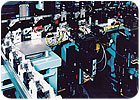
Automation vs. Lean Manufacturing
Lean manufacturing has been touted as the panacea for the production world. However, the idea of capital equipment expenditure in a lean system is viewed as an oxymoron by some observers. They question the role of automation in an environment they perceive to be the domain of manual assembly processes.
Many manufacturing engineers confuse lean initiatives and automation projects. To thrive in a lean environment, engineers must break the age-old habit of always wanting to buy the fastest machine equipped with the latest bells and whistles. The trick is to challenge complexity and balance the right amount of automation to meet lean objectives and customer needs.
Because manufacturing engineers tend to overautomate, one of the biggest challenges assemblers face when implementing lean production principles is determining how much automation to use. The trick is getting the right level of automation. Not enough automation could result in a loss of efficiency, while too much automation could increase costs and reduce reliability.
“While all companies today are looking to implement some level of lean into their assembly process, lean does not mean the elimination of automation,” says Mark Dinges, product marketing manager for modular assembly conveyors at Bosch Rexroth Corp. “It has more to do with the elimination of waste. Assembly operations that are highly repetitive, heavy or extremely precise are typically best accomplished through automation.”
Some engineers mistakenly believe that conveyors, parts feeders and other forms of high-speed automation don’t have a place in lean manufacturing. However, lean initiatives can work successfully in an automated environment. In fact, many lean principles work just as well with high-speed automated assembly equipment as with manual assembly processes.
No matter how a product is assembled, continuous improvement, customer focus, one-piece flow, pull, value and waste elimination play a key role in lean manufacturing. The goal is to eliminate non-value-added activities that prevent a one-piece flow of product. Whether an assembly process is manual or fully automated, lean manufacturing shortens the time between customer order, product build and shipment by eliminating sources of waste.
Modular conveyors are ideal for lean manufacturing because they can be reconfigured in response to changes in product mix or production volume. They feature bolt-together components such as aluminum framing. By purchasing reconfigurable equipment, manufacturers are able to minimize low-value processes, such as mechanical assembly, and focus on high-value processes, such as controls and station integration.
“In the case of modular assembly conveyors, fixturing of the workpiece pallet should be planned carefully,” says Dinges. If a pallet will require extensive machining, he suggests purchasing the pallet unassembled.
“It’s much easier to machine a steel or aluminum plate, as opposed to an assembly,” explains Dinges. “Press-fit bushings, which are commonly used in the assembly of a pallet, are not compromised by being pressed in and out of the pallet plate.”
Fixture design for automated assembly systems is critical. However, it’s important to keep it as simple as possible, while still being functional for all process stations. One major "don’t" is fixture design. Don’t design a feature into every fixture than can be dealt with adequately in the tooling of one specific station where it is needed. Fixtures should be designed to transport and locate. But, moving parts and elements that are delicate, or are subject to wear or fatigue, should be avoided.
According to Dinges, most actual pallet payloads are heavier than planned, which can cause problems. To avoid any future overload situations, he recommends purchasing a drive with excess pulling capacity.
Dinges also says it’s a good idea to wait until the conveyor, including its motor, is onsite before purchasing any motor overloads. “While all motor overloads do include a range of operation, this range varies from supplier and by type,” he warns.
“In some cases, the range of a certain overload may not overlap with the amperage ratings of a motor,” Dinges points out. And, to optimize airflow and ensure correct operation of stops, rockers and other pneumatically actuated components, he suggests trying “to limit the maximum length of pneumatic tubing from a valve to a cylinder.”
Vibratory bowl feeders can also cause headaches for manufacturing engineers. One common mistake is trying to force the bowl to feed parts the way you want them oriented, rather than taking them the way they will feed the most reliably and then reorienting them.
Reliably feeding at rate is more important than getting parts delivered exactly as needed. An entire feed system will suffer terribly if only one feed system is struggling to maintain pace.
Another common mistake with vibratory feeders is using them as storage bins rather than providing auxiliary hoppers to maintain the correct level of parts in the bowl. Vibratory bowls are built to operate at rate with a nominal amount of parts. Their job is to move, singulate, orient and deliver components to the machine. When overloaded with parts, vibratory bowls don’t perform as well.
One definite "do" for feeders, especially when performance is critical in terms of speed or degree of difficulty, is to run-off the feeders at the bowl builder’s site. This ensures that fixes or corrections occur as they should. Once [feeders are] shipped, feeder problems are more likely to be addressed with patches or jerry-rigging.
Flexibility and Product Mix
Today, being flexible is more important than ever. Reusable and reconfigurable automation benefits manufacturers because the equipment can be used for more than one product line or more than one assembly process.
Agile assembly systems allow manufacturers to react quickly to shifting customer demands and shorter product life cycles. They can produce a wider variety of products; alter the mix of options or features; add new processes or assembly stations easily; and change volumes with minimal investment and changeover loss.
All standard assembly platforms are designed to be flexible. They have to be toolable for a wide variety of applications and products. But, once a flexible platform is tooled for a specific product, the idea of flexibility must be reassessed in terms of that product and its "mix."
The most common mistake is overdoing it. Specifications provided with RFQs are usually guilty of pushing the equipment vendor into a corner. After assuring the end user of one’s platform flexibility and great tooling design talent, it is difficult to speak negatively about the overspecification of flexibility requirements.
Many manufacturers lock themselves into product designs that will only support manual processes. It’s better to "forward think" the assembly process, design the components and the component manufacturing processes to support higher volume and, if necessary, do the low-volume assembly at a lesser efficiency.
Integrators often see product components that are designed for low-volume, manual processing. Then, the production volumes increase and the manufacturer wants to automate. But, the component manufacturing processes are already in place, and the manufacturer is hesitant to retool the components. The result is that integrators get a request to automate a very troublesome process.
Most automated assembly lines are built to handle many variations of a product or a family of parts. A common mistake is to push the envelope too far.
Sometimes, production levels will be greater if equipment is operated at a somewhat lower cycle rate. Consistent quality levels may be enhanced greatly by operating at speeds that are not straining the performance levels of feeders, presses, dispensers, welders, tooling and other equipment. Only high-volume versions of the product mix should be addressed if extreme design acrobatics are required to handle the variations.
Manufacturers often underestimate the impact on uptime and performance that complicated changeovers can have. One key for successfully operating complex systems is correct training of technicians and operators. It is best to match the level of equipment sophistication with that of the operating environment.
Changeover of equipment for product variations is affected by a number of different issues. There is always a strong desire to automate the process as much as possible. Many people think this simplifies the operation of the equipment. It does simplify it--if the operators are technically proficient and correctly trained to understand the changeover procedures.
A lot of design time and capital costs can be avoided by implementing simple, straightforward manual changeover procedures that are more easily understood by the people involved.
Know What You Want
At the beginning of any automation project, it’s important to conduct an item by item review of the specifications to be sure that both you and your system integrator are on the same page. Failure to do this can lead to delays, disagreements and disappointments for both sides.
Integrators see many customers with a low-volume, high-mix product that they would like to automate. The problem is that they frequently request an automation proposal for just one segment of the mix. Very often, the volume from one product segment will not support the justification for automation.
Customers with this product mix problem are frequently job shops, contract manufacturers or manufacturers of low-volume, high-end products. They would be better served by partnering with an automation builder to look at the broad range of products with an eye toward developing a flexible process that would address the family of products.
“Most of our customers come to us with a detailed specification describing the features, process requirements and performance expectations they have for the piece of custom equipment that we are to design and build,” notes Robert Ensminger, president of the Arthur G. Russell Co. “The person writing the specification usually has a clear picture of what they are trying to convey, but it may not be detailed enough for another person to read and develop the same mental picture.”
Whenever problems arise, Ensminger says poor communication is often the culprit. Unfortunately, this situation is typically compounded by the size of the organizations involved in the discussion.
“The larger the organization, the more people have to be involved in getting information,” says Paul Kuchay, business unit manager at BBS Automation. “If we, as machine builders, don’t get timely answers to our questions, the project stalls. Or worse, if we get the wrong information, then we might make assumptions based on flawed information.”
Sometimes, it’s like trying to hit a moving target. “[Often], our customers are marketing-driven,” explains Kuchay. “The marketing department tells the engineering department that they have to have a production line ready to run 10,000,000 units a year in 6 months. They concurrently buy the equipment and tweak the final package or product to the point where it requires a significant redesign of several sections of the machine.
“This happens all the time,” claims Kuchay. “Marketing and engineering need to work together and define limits to how many things can change, and by how much. This is very common; we battle this almost every day.”
The biggest problem for automation customers is they don’t concentrate on design for manufacturability. And, they don’t involve the assembly integrator early enough in the design process to have a significant impact on the equipment necessary to put the product together.
Through a collaborative relationship with the systems integrator or machine builder, manufacturers can shorten lead times, reduce capital expenditures and minimize the nuisance fault issues that affect production downtime.
When an existing manual or semiautomatic assembly process is to be automated, manufacturing engineers should pay careful attention to the quality of the actual product that is expected to be run on the proposed machine. “Human operators become very adept at making adjustments for parts that are less than perfect, but the automatic machine will not be as forgiving,” warns Ensminger. “It is important to carefully compare actual product samples with part prints, and then agree ahead of time regarding what will be considered ‘acceptable’ in terms of product quality.
“From there, agreement can be made on realistic expectations regarding the efficiency of the equipment,” adds Ensminger. “No matter how well designed and built, an automatic assembly machine will exhibit poor performance if the product placed into the machine is of poor quality.”
Problems also arise when machine builders are asked to create equipment for new products. “The molded parts that we are provided in the early stages of the project often come from prototype molds,” says Ensminger. “Even though the production molds were made to the same product drawings as the prototype, the parts from the production mold will often vary relative to the prototype parts.
“If a project will require the use of prototype parts for initial test and development, and the production parts will arrive for final debug and test, some allowance must be made for potential delays and added costs that may result,” Ensminger points out.
According to Bosch Rexroth’s Dinges, it’s always a good idea to define the entire assembly process-including all manual and automated stations-before starting any project. He says systems integrators should ensure that their cycle time calculations meet the customer’s takt time.
“While this should be a given, we’ve seen applications in which an assembly system cannot even meet a customer’s initial production requirements,” explains Dinges. “For end users that do their own integration, make sure you have experienced associates to integrate the controls and wiring, as well as to handle any debug requirements.”
Work as a Team
The effects of outsourcing, offshore production, layoffs, early retirements and lean manufacturing have changed the rules of doing business with systems integrators. Today, product life cycles are shorter and customer expectations are higher; equipment delivery times are shorter and manufacturers hold onto their money longer.
Many machine builders and systems integrators have been struggling to survive. Meanwhile, due to downsizing and other factors, more and more manufacturers have come to depend on integrators for project management support services.
Integrator and manufacturer must become one team to deliver cost-effective equipment on tight schedules. The more closely each side listens to and trusts the other, the more effective the relationship will ultimately be.
Don’t handicap your automation builder: Partner with it and share all of your automation plans.
The most important factor for success in any automation project continues to be the early involvement of the integrator. It’s always a good idea to work with automation vendors as soon as possible. Early involvement typically results in better specifications, less technical risk, fewer changes and a better understanding of the entire project.
Effective project management is the other basic tenant of successful automation systems. Lack of parts, prints and specifications, or the inability to juggle numerous tasks, will slow down even the biggest and best automation project.
Review floor plans and equipment placement as early as possible. Ergonomic aspects of the process need to be addressed in the early concept and design stages. This prevents time and cost impacts when ergonomic [factors are] considered at build or run-off of equipment.
It’s also important to review cycle time requirements for optimum equipment throughput. Faster cycle time does not mean more parts per hour. Equipment reliability and mean time between failure are two additional factors that need to be considered for system throughput.
In addition, manufacturing engineers should be aware of the number of variants and the complexity they add to the production equipment. Keep in mind, just because it can be done does not mean it should be.
Engineers also should supply a complete set of part prints to the integrator and a clear definition of equipment performance and tolerances. This up-front agreement eliminates later unknowns or misunderstandings of requirements.
Engineers should understand what part or assembly data is critical, and develop collection methods early in the design phase. Lessons learned from past automation projects should always be reviewed at the start of any new project.
Sidebar: 12 Reasons Why Automation Projects Fail
Brian Turner, vice president and general manager of Distefano Technology and Manufacturing Co., says automation projects fail for several different reasons:
- Not providing an equipment specification.
- Not recognizing that specification development is a two-step process.
- Closing an automation concept without researching all the various possibilities.
- Incorrectly estimating the total cost of an automation project.
- Failure to visit prospective automation suppliers.
- Not having enough technical capability in-house.
- Failure to involve operators.
- Poor communication with the supplier.
- Accepting the equipment before it is ready.
- Failure to provide the supplier with up-to-date drawings and quality parts.
- Failure to design the product for automation.
- Using the wrong technology.
Sidebar: Don't Assume Outsourcing Is "Better" Than Automation
Often, companies compare piece-price costs for a product with corresponding costs in Brazil, China, India, Mexico or elsewhere, then add in the cost of slow freight-usually container ship-when deciding whether or not to outsource.
“This is mass-production math, and it is no longer realistic,” claims James Womack, Ph.D., chairman of the Lean Enterprise Institute. He urges senior managers to perform a more accurate analysis of total costs.
A lean math cost analysis should include:
- Cost of additional inventory of goods shipped over long distances from the low-wage location to customers.
- Cost of additional safety stocks to ensure uninterrupted supply over long distances from the low-wage country.
- Cost of expensive expedited shipments from the low-wage supplier.
- Cost of lost sales caused by stock-outs due to longer lead times because of longer transport distances.
- Cost of warranty claims if the new supplier has a long learning curve.
- Cost of engineer visits to help the new supplier get the product or service right.
- Cost of senior executive visits to establish or correct relationships with new suppliers.
- Overhead costs allocated to operations remaining in the high-wage location, which usually don’t disappear when products or services are outsourced.
According to Womack, these additional costs are rarely visible to senior managers or purchasing executives who relocate production to a low-wage country based simply on piece-price. “The reason is that these additional costs are paid by different functions in the company, because they are allocated on a budget basis-not a product-line basis,” he points out.
Any cost analysis should also include currency and country risks, plus the danger that the new supplier will become unstable or a competitor. “Because these risks are hard to calculate precisely, senior managers tend to assume they are zero when, in reality, they can be substantial,” warns Womack.
“Offshoring is not the first line of defense for producers in high-wage countries,” adds Womack. “Rather, senior managers must get serious about using lean principles and tools to improve the design, quality, cost and delivery of the product in question, then implement lean management to sustain the gains.”


